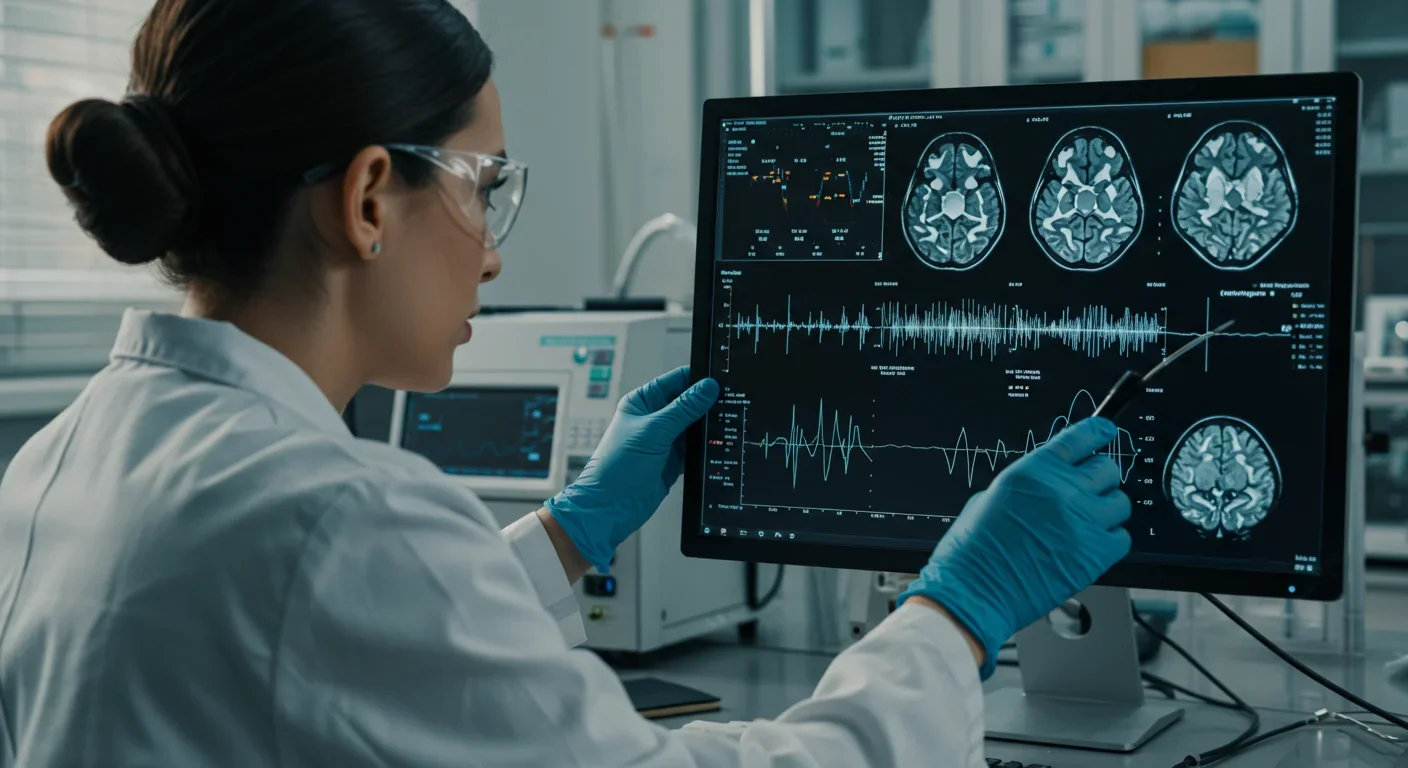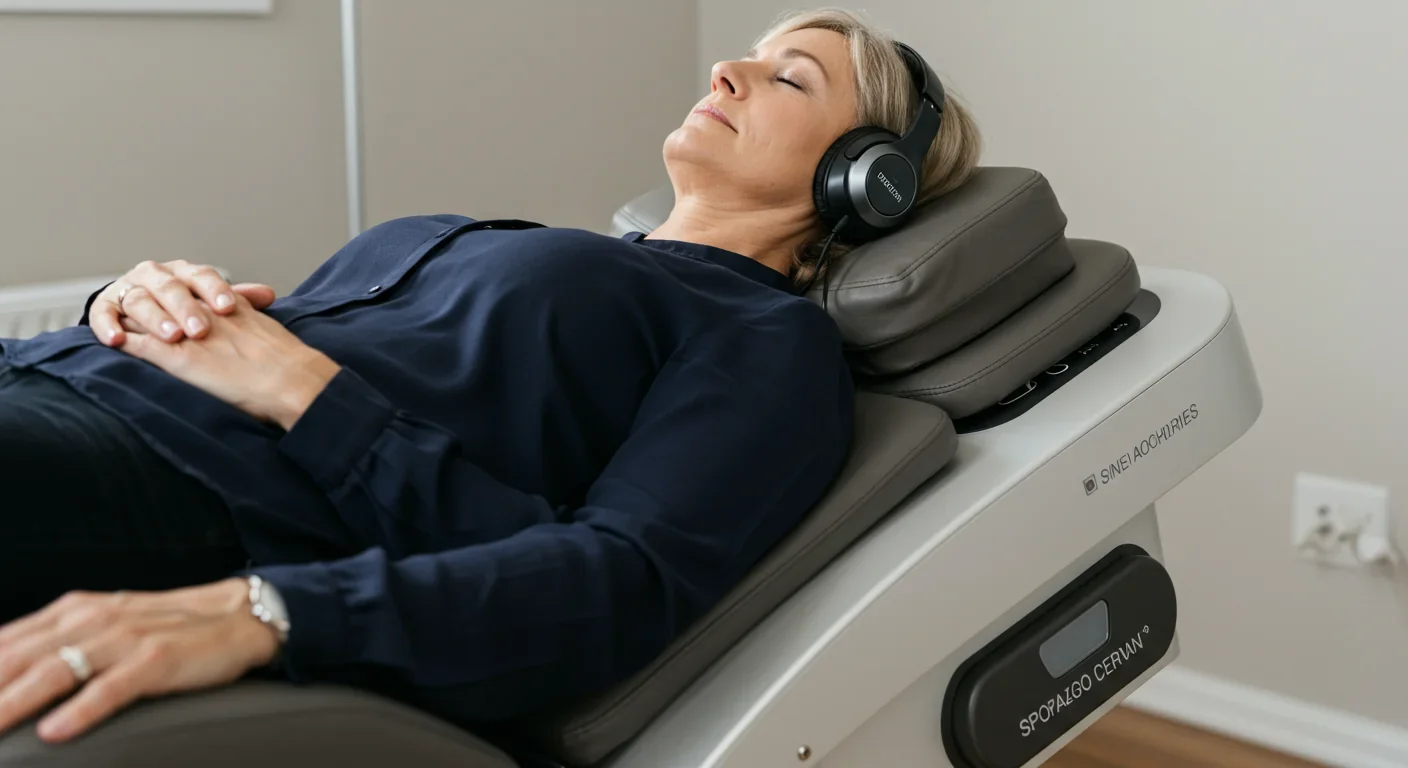Ultrafine Particles Breach Brain Barriers: Hidden Risk

TL;DR: Sound frequencies can trigger measurable biological responses at the cellular level, from clearing brain plaques in Alzheimer's patients to reducing chronic pain. The science is moving sound therapy from wellness trend to evidence-based medicine.

By 2030, scientists predict that sound-based therapies could become as routine in medical practice as prescribing antibiotics. What sounds like science fiction is actually grounded in decades of research showing that specific frequencies can influence everything from DNA repair to Alzheimer's symptoms. The human body, it turns out, isn't just a chemical system but a vibrational one, and we're only beginning to understand how to tune it.
For years, the wellness world has championed sound healing, often without solid scientific backing. That's changing fast. Recent studies have uncovered something remarkable: cells don't just respond to sound, they actually appear designed to interact with specific frequencies. Research published in Frontiers demonstrates that acoustic fields can influence cellular interaction patterns, suggesting that sound operates as a fundamental communication mechanism at the microscopic level.
The most compelling evidence comes from Alzheimer's research. Scientists discovered that 40 Hz gamma frequency stimulation triggers microglia, the brain's cleanup crew, to clear toxic amyloid plaques. In mice studies, this sensory therapy reduced plaque buildup by up to 50% after just one week of daily exposure. Human trials are now underway, with early results showing promise for slowing cognitive decline.
What makes this particularly revolutionary is the mechanism. Unlike drugs that force biochemical reactions, frequency therapy appears to work with the body's existing systems. Think of it like this: if your cells are an orchestra, sound therapy isn't introducing new instruments but helping the existing musicians play in harmony.
The idea that sound heals isn't new, but science's ability to prove it is. Ancient cultures used chanting, drumming, and vocal toning for healing, practices dismissed by modern medicine as placebo at best. The Pythagoreans believed in the "music of the spheres," a cosmic harmony they thought governed health and disease. Indigenous healing traditions worldwide incorporated specific rhythms and frequencies long before we had oscilloscopes to measure them.
The scientific journey began in the 1960s when Swiss physician Hans Jenny pioneered cymatics, the study of visible sound. By vibrating plates covered with sand or liquid at different frequencies, Jenny revealed that sound creates intricate geometric patterns. At 432 Hz, water forms mandala-like structures. Change the frequency, and the pattern transforms entirely. The implication was staggering: if sound organizes matter this precisely, what's it doing inside our bodies, which are 60% water?
But cymatics remained curiosity rather than clinical tool, because we lacked understanding of the biological mechanisms. That changed with the discovery of mechanotransduction, the process by which cells convert mechanical stimuli into biochemical signals. Suddenly, there was a pathway: sound waves create mechanical vibrations, which cells detect through specialized proteins, triggering cascades of biological responses.
The parallels to other technological shifts are striking. Just as germ theory revolutionized medicine by revealing an invisible world affecting health, frequency research is revealing that vibration, another invisible force, may be equally fundamental. We went from bloodletting to antibiotics because we understood pathogens. Now we're moving from symptom suppression to frequency modulation because we're understanding resonance.
Historical medical revolutions followed a pattern: initial skepticism, accumulating evidence, mainstream acceptance, and eventual ubiquity. Handwashing faced resistance until doctors saw infection rates plummet. Sound therapy is following this exact trajectory, moving from fringe to frontier.
Here's where it gets fascinating. Your cells aren't passive blobs, they're dynamic structures constantly vibrating at their own frequencies. Every protein, every membrane, every organelle has what's called a resonant frequency, the rate at which it naturally oscillates. When external sound waves match these frequencies, resonance occurs, amplifying the cellular response.
The cell membrane, that crucial barrier between inside and outside, behaves like a drum skin. Research on vocal fold vibration reveals that mechanical vibrations alter membrane dynamics, affecting how molecules pass through and how cells communicate. This isn't metaphorical, it's measurable physics happening in real time.
Specific frequencies appear to trigger specific responses. The 528 Hz frequency, part of the ancient Solfeggio scale, has been linked to DNA repair mechanisms, though the evidence here is more preliminary than the Alzheimer's work. What's clear is that frequency matters enormously. Play a 40 Hz tone, and you might activate neuronal cleanup pathways. Play 528 Hz, and you could be influencing cellular regeneration. It's not magic, it's targeted mechanical signaling.
The technical term is vibroacoustic effect. Sound waves travel through tissue as pressure waves, creating micro-movements at the cellular level. These movements activate mechanoreceptors, which trigger ion channels to open or close, altering the cell's electrical potential and chemical environment. It's like ringing a doorbell that sets off a whole sequence of events inside the house.
Laboratory studies show that low-intensity pulsed ultrasound enhances production of growth factors that promote bone formation and blood vessel development. The mechanism involves acoustic stimulation of stem cells, which respond by secreting healing compounds. Frequency becomes a control dial for cellular behavior.

If this research bears out, we're looking at a fundamental shift in medical paradigm. Right now, healthcare treats the body primarily as a chemical system: disease happens when chemistry goes wrong, so we intervene with pharmaceutical chemistry to correct it. That model has given us antibiotics, insulin, and countless life-saving drugs.
But what if the body is also, perhaps primarily, an electrical and vibrational system? What if many conditions involve not just chemical imbalance but frequency dysregulation? This doesn't replace pharmacology, but it expands our toolkit dramatically.
Consider music therapy's emerging role in cancer treatment. Studies show that specific musical interventions can modulate immune responses and potentially enhance treatment outcomes. Patients receiving music therapy alongside conventional treatment report better mood, lower pain levels, and improved immune markers. The sound isn't curing cancer directly, but it's optimizing the body's terrain for healing.
The implications for chronic disease management are profound. Conditions like chronic pain, anxiety, insomnia, and inflammatory disorders might respond to frequency-based interventions with fewer side effects than current treatments. Imagine prescribing a playlist instead of a pill, a sound bath instead of a sedative.
This also democratizes healing in powerful ways. A pharmaceutical requires massive infrastructure, patents, distribution networks, and hefty price tags. A frequency can be delivered through headphones, speakers, or vibrating platforms at minimal cost. Once we identify therapeutic frequencies and optimal delivery methods, access becomes nearly universal.
But there's also risk of oversimplification. The body is extraordinarily complex, and frequency therapy isn't a panacea. Early marketing of "miracle frequencies" and exaggerated claims have muddied the waters, making rigorous research harder to distinguish from pseudoscience. That's why the current moment, with solid peer-reviewed studies emerging, is so critical.
Let's talk about what's actually working right now, not speculation but documented benefits. Sound baths, immersive experiences using singing bowls, gongs, and tuning forks, have shown measurable effects on stress reduction. Studies using heart rate variability and cortisol measurements confirm what participants report: deep relaxation and nervous system regulation.
The mechanism involves activating the parasympathetic nervous system, your body's rest-and-digest mode. The slow, resonant tones characteristic of sound baths shift brain waves from beta (alert, active) to alpha and theta (relaxed, meditative). This isn't subjective, it shows up clearly on EEG readings.
Binaural beats offer another evidence-backed application. When you play slightly different frequencies in each ear, your brain perceives a third frequency equal to the difference between them. Play 200 Hz in the left ear and 210 Hz in the right, and your brain generates a 10 Hz rhythm, in the alpha range associated with relaxation and creativity. Research shows binaural beats can reduce anxiety, improve focus, and enhance meditation depth.
For pain management, vibroacoustic therapy uses low-frequency sound vibrations delivered through special chairs or mattresses. Patients with fibromyalgia, arthritis, and chronic back pain report significant relief, with studies confirming reduced pain scores and improved mobility. The vibrations appear to reduce muscle tension and increase local blood flow.
The Alzheimer's research mentioned earlier represents perhaps the most exciting frontier. If 40 Hz stimulation, delivered through flickering lights or pulsing sounds, can slow neurodegeneration, it could buy precious time for millions of patients. The beauty of the approach is its safety profile: no drugs, no surgery, just carefully calibrated sensory input. Early human trials show it's well-tolerated, and efficacy data should emerge within the next few years.
Music therapy, once relegated to complementary care, is gaining mainstream traction. Hospitals now employ certified music therapists who design personalized sound interventions for everything from neonatal care to end-of-life comfort. The evidence base has grown robust enough that insurance increasingly covers these services.
Here's where critical thinking becomes essential, because the sound healing space is rife with wild claims unsupported by data. You'll find products promising that 528 Hz repairs DNA or that certain tones can "raise your vibration" to attract abundance. These claims range from speculative to outright fraudulent.
The actual research on 528 Hz and DNA is far more nuanced. Some in-vitro studies suggest it may influence repair enzyme activity, but we're nowhere close to proving it fixes genetic damage in living humans. The leap from test tube to therapeutic application is vast, and marketers often skip right over it.
There's also the problem of mechanism confusion. Just because something feels good doesn't mean we understand how it works. The relaxation you feel during a sound bath might come from the meditative context, the social bonding, the quiet time, or the frequencies themselves. Teasing apart these variables requires careful experimental design, which is expensive and time-consuming.
Standardization poses another hurdle. Unlike pharmaceuticals, which have precise dosing and purity standards, sound therapy varies wildly. What frequency exactly? What amplitude? What duration? What delivery method? These details matter enormously, but practitioners often wing it based on tradition or intuition rather than evidence.
The field needs better regulation. Currently, anyone can claim to be a sound healer with zero training or accountability. This erodes credibility and potentially harms people who forego evidence-based treatment for unproven alternatives. Professional certification, practice standards, and integration with conventional medicine would help immensely.
We also face a credibility gap born of history. Sound healing's association with New Age spirituality makes some scientists dismiss it out of hand, while true believers often reject calls for rigorous testing as "Western reductionism." Both extremes hinder progress. What we need is open-minded skepticism: willing to investigate, but demanding solid evidence.
Safety considerations matter too, though risks appear minimal compared to many interventions. Very loud sounds can damage hearing, but therapeutic applications use moderate volumes. Certain frequencies might trigger seizures in epileptic individuals, something practitioners need awareness of. And for serious conditions, sound therapy should complement, not replace, proven treatments.

What's happening around the world right now is remarkable. In Germany, frequency-based therapy has entered mainstream rehabilitation, with clinics using cymascope technology to analyze and treat various conditions. The approach involves recording a patient's vocal sounds, analyzing their frequency patterns, and identifying dissonances that might reflect physiological stress.
Japan has long embraced sound in healthcare, with hospitals incorporating ambient soundscapes designed to reduce patient stress and promote healing. Recent expansions include whole-room resonance chambers that immerse patients in therapeutic frequencies, showing promise for pain management and psychological support.
The United States is catching up. Major medical centers including Johns Hopkins and UCLA now have integrative medicine departments where sound therapy sits alongside acupuncture and meditation as evidence-based complementary approaches. The National Institutes of Health has funded several studies on music and sound interventions, lending credibility to what was once fringe.
Meanwhile, Silicon Valley is doing what it does: technologizing. Startups are developing apps that deliver personalized binaural beats, AI-driven therapeutic playlists, and wearable devices that vibrate at healing frequencies. Some of this is genuinely innovative, some is repackaging ancient practices with slick interfaces, but it's bringing frequency therapy to millions of smartphones.
International collaboration is accelerating discoveries. Researchers in Finland studying how sound affects circadian rhythms are sharing data with chronobiologists in Australia investigating frequency-based sleep interventions. Scientists in South Korea exploring ultrasound for drug delivery are comparing notes with Swiss teams using sound to enhance chemotherapy efficacy. The convergence of expertise is yielding insights no single lab could achieve.
Cultural exchange is enriching the field too. Indigenous sound healing traditions from Africa, Australia, and the Americas offer practices refined over millennia. As respectful collaboration increases between traditional practitioners and research scientists, we're seeing ancient wisdom validated by modern measurement, and vice versa.
So what does this mean for you? How do you navigate the hype and find what actually works? Start with the evidence. The strongest data supports sound for stress reduction, sleep improvement, pain management, and mental health support. Those are legitimate applications you can explore now.
If you're curious about sound baths, seek practitioners affiliated with professional organizations like the Sound Healers Association or the Global Professional Association for Therapeutic Sound. Ask about their training and what specific outcomes they've observed. A good practitioner will be honest about what's proven versus what's exploratory.
For home use, binaural beats offer an accessible entry point. Apps like Brain.fm and Endel use scientifically-designed soundscapes tailored to focus, relaxation, or sleep. The research here is promising enough to experiment safely. Use headphones for binaural beats to work properly, and start with shorter sessions to gauge your response.
Music therapy is another low-risk, high-reward option. Curate playlists that match your desired state: slow, low-pitched sounds with minimal variation for relaxation; moderate tempo, major keys for mood elevation; rhythmic, repetitive patterns for focus. Pay attention to what actually shifts your physiology, not just what you think should work.
If you're dealing with chronic health issues, discuss sound therapy with your healthcare provider as a complement to conventional treatment, not a replacement. Some conditions, like Alzheimer's or chronic pain, have enough evidence that your doctor might actively support adding frequency-based interventions to your care plan.
Stay skeptical of claims that sound can cure serious diseases or replace medical treatment. The research simply doesn't support those assertions yet. What it does support is sound as a tool for optimizing your body's existing healing capacities, reducing stress-related dysfunction, and enhancing overall well-being.
We're standing at a fascinating threshold. For the first time, we have both the ancient wisdom about sound's healing power and the modern tools to understand and optimize it. The convergence could transform medicine, making it more personalized, less invasive, and dramatically more accessible.
The next decade will be crucial. As larger clinical trials complete, as mechanisms become clearer, as delivery methods improve, we'll separate what works from what doesn't. Some current claims will be validated, others debunked, and entirely new applications will likely emerge.
What seems certain is that we've been thinking about the body too narrowly. Chemistry matters, but so does vibration. Structure matters, but so does resonance. The body isn't a machine with broken parts needing chemical fixes, it's a symphony occasionally falling out of tune.
Learning to listen, learning to adjust the frequencies, learning to work with the body's vibrational nature might unlock healing modalities we've barely imagined. The science is still early, but the signal is getting clearer: we are beings of sound as much as flesh, and learning our frequencies might be learning to thrive.
The question isn't whether sound affects us, that's established. It's how precisely we can harness those effects to enhance human health and potential. That's the research happening right now in labs and clinics worldwide, and the implications ripple far beyond wellness circles into the foundations of how we understand life itself.
Sound has always shaped human experience, from the rhythms that regulated our ancestors' days to the music that stirs our emotions. Now we're discovering it shapes us at the deepest level, in the vibrations of our cells and the frequencies of our thoughts. Tuning into that reality might be the next great leap in human health and consciousness.

MOND proposes gravity changes at low accelerations, explaining galaxy rotation without dark matter. While it predicts thousands of galaxies correctly, it struggles with clusters and cosmology, keeping the dark matter debate alive.

Ultrafine pollution particles smaller than 100 nanometers can bypass the blood-brain barrier through the olfactory nerve and bloodstream, depositing in brain tissue where they trigger neuroinflammation linked to dementia and neurological disorders, yet remain completely unregulated by current air quality standards.

CAES stores excess renewable energy by compressing air in underground caverns, then releases it through turbines during peak demand. New advanced adiabatic systems achieve 70%+ efficiency, making this decades-old technology suddenly competitive for long-duration grid storage.

Our brains are hardwired to see patterns in randomness, causing the gambler's fallacy—the mistaken belief that past random events influence future probabilities. This cognitive bias costs people millions in casinos, investments, and daily decisions.

Forests operate as synchronized living systems with molecular clocks that coordinate metabolism from individual cells to entire ecosystems, creating rhythmic patterns that affect global carbon cycles and climate feedback loops.

Generation Z is the first cohort to come of age amid a polycrisis - interconnected global failures spanning climate, economy, democracy, and health. This cascading reality is fundamentally reshaping how young people think, plan their lives, and organize for change.

Zero-trust security eliminates implicit network trust by requiring continuous verification of every access request. Organizations are rapidly adopting this architecture to address cloud computing, remote work, and sophisticated threats that rendered perimeter defenses obsolete.